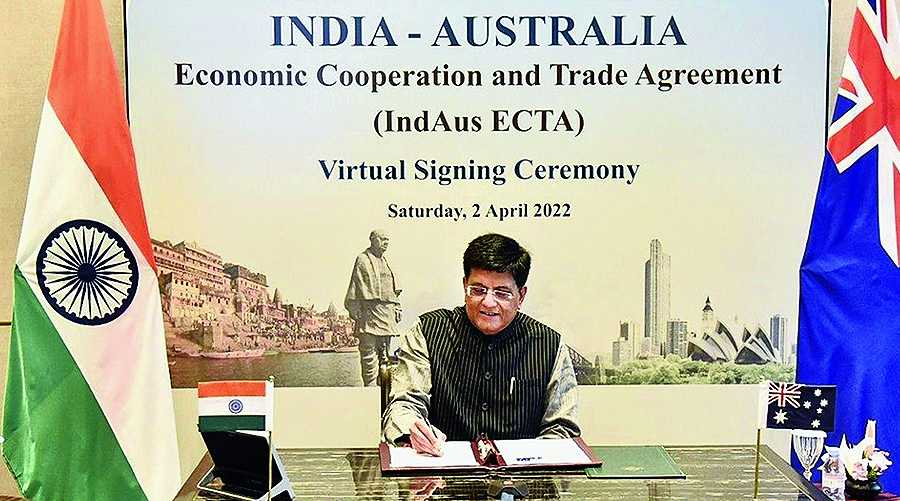India and Australia signed an Economic Cooperation and Trade Agreement (IndAus ECTA), hailing it as a watershed moment and one of the biggest economic doors there is to open in the world. It will provide zero-duty access to 96 per cent of India’s exports to Australia, including shipments from key sectors like engineering goods, gems and jewellery, textiles, apparel, and leather.
Buy Prime Test Series for all Banking, SSC, Insurance & other exams
Key Points:
- According to a government estimate, the agreement will increase bilateral trade in products and services to $45-50 billion over the next five years, up from roughly $27 billion, and create over one million employees in India.
- Around 85% of Australia’s exports, including coal, sheep meat, and wool, will have zero duty access to the Indian market, while Australian wines, almonds, lentils, and select fruits would have lower duty access.
- Under the deal, zero-duty access for Indian goods will be expanded to 100% over the next five years.
- It is India’s first Free Trade Agreement (FTA) with a large developed country in more than a decade. India inked an FTA with the UAE in February and is actively negotiating FTAs with Israel, Canada, the United Kingdom, and the European Union.
- In a virtual ceremony attended by Prime Minister Narendra Modi and Prime Minister Scott Morrison, Commerce and Industry Minister Piyush Goyal and Australia’s Minister for Trade, Tourism and Investment Dan Tehan signed the deal.
- Indian STEM (Science, Technology, Engineering, and Mathematics) graduates will be awarded extended post-study work visas under the deal. Australia will also establish a programme to provide visas to young Indians who wish to spend their vacations working in the country.
Highlights of the Trade Agreement:
- The pact will increase bilateral trade to $45-50 billion in five years and create over one million jobs in India.
- Many labour-intensive Indian exports currently face a tariff disadvantage of 4-5 percent compared to competitors — those with FTAs with Australia — such as China, Thailand, and Vietnam. Officials claim that removing this barrier would greatly boost merchandise shipments.
- In FY2021, bilateral goods and services trade between India and Australia was $27.5 billion. In FY2022, merchandise exports to Australia grew at a quicker rate than exports to any other country.
- Exports of Indian goods and services to Australia are predicted to hit $20 billion in FY2027 and $35 billion in FY2035, up from around $10.5 billion in FY2021.
About Trade Agreement:
- Under the agreement, Australian wine imports, almonds, lentils, oranges, mandarins, pears, apricots, and strawberries will all benefit from decreased duties.
- However, in order to protect “sensitive sectors,” India has excluded a number of Australian items from tariff reductions, including dairy products, wheat, rice, chickpeas, beef, sugar, apples, toys, and iron ore.
- Australia will profit from zero-free access to coal, which now accounts for roughly 74% of Australia’s exports to India and is subject to a 2.5 percent charge.
- The abolition of taxes on coking coal, which accounts for around 73% of all coal imports, is projected to increase Indian steel exports’ competitiveness. Over the next ten years, Australia’s zero-duty access will expand to cover 91% of its exports by value and over 70% of India’s tariff lines.
- When the deal takes effect, taxes on LNG, wool, sheep meat, alumina, and metallic ores will be erased, while duties on avocados, onions, pistachios, macadamias, cashews in shell, blueberries, raspberries, and blackberries will be eliminated over a seven-year period.
- Tariff-rate quotas would be used to provide lower charges on products like cotton, lentils, oranges, almonds, and mandarins, with tariffs returning to pre-agreement levels for imports exceeding threshold quantities.
- For example, lentil imports from Australia up to 1.5 lakh tonnes will only be subject to a 15% total import duty, compared to 30% charges on lentil imports from countries with whom India does not have trade agreements.
- The agreement also contains tight origin restrictions to prevent products from being routed through other countries and a safeguard system to manage any abrupt increases in product imports.
Advantage of the Agreement:
- Duty reductions on Australian wines would be phased gradually over time dependent on pricing. Wines with a minimum import price of $5 per 750 ml bottle will see a reduction of 150 per cent to 100 per cent when the agreement goes into effect and a further 50 per cent reduction over the next ten years. When the deal takes effect, tariffs on wine priced above $15 per 750 ml bottle will be reduced to 75%, and over the next ten years, they will be reduced to 25%.
- The deal will also help Australian authorities to approve Indian medications more quickly because they have agreed to use inspection reports and approvals from Canada and the EU in their examination of Indian pharmaceuticals and manufacturing facilities.
- Australia has also agreed to alter local taxation regulations to avoid the taxation of offshore revenue of Indian enterprises providing technical services to Australia, addressing a long-standing complaint of Indian IT firms about double taxation.
Find More News Related to Agreements



 Indian Olympic Medal Winners List Till N...
Indian Olympic Medal Winners List Till N...
 Who is the Inventor of the Gramophone?
Who is the Inventor of the Gramophone?
 HS Dhaliwal Appointed New DGP Of Andaman...
HS Dhaliwal Appointed New DGP Of Andaman...
